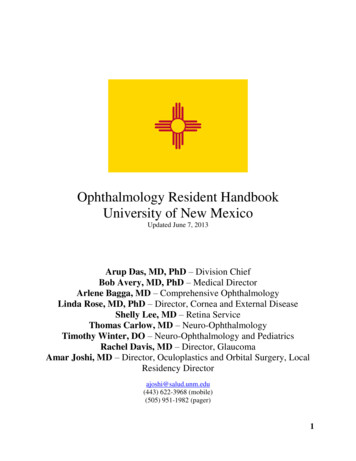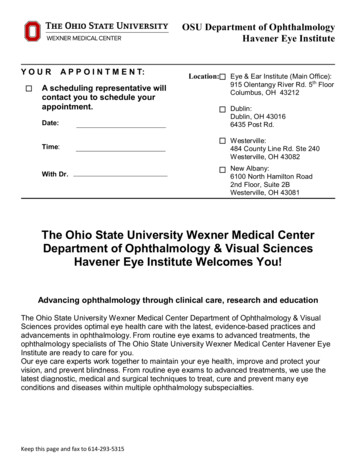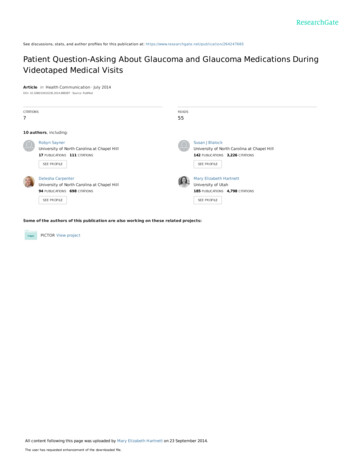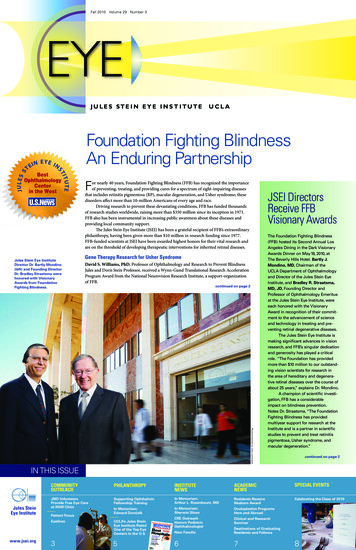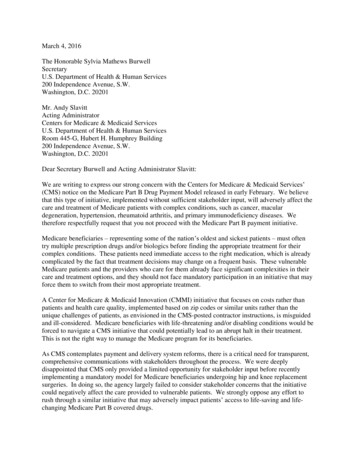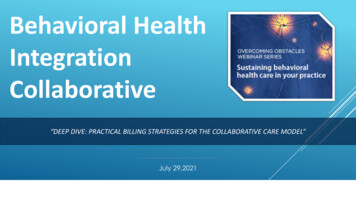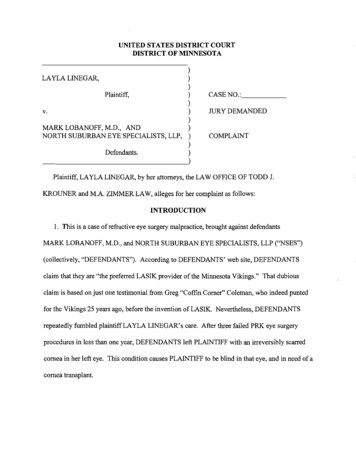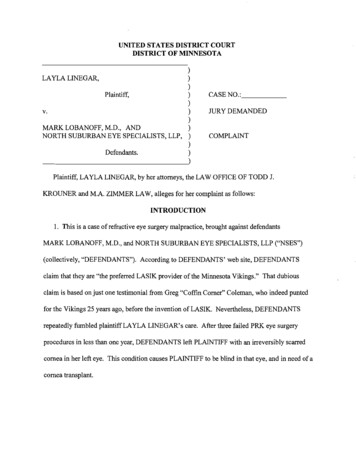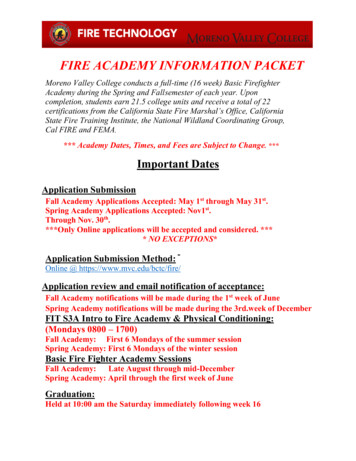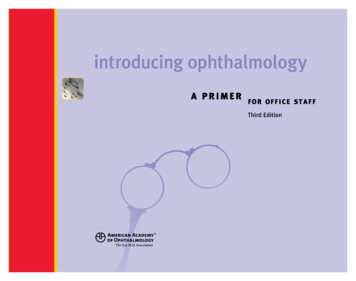
Transcription
introducing ophthalmologya pr imerfor off ice st a f fThird Edition
655 Beach StreetP.O. Box 7424San Francisco, CA 94120-7424introducing ophthalmology: a primer for office staffO phthalmology L iaisons C ommitteeSamuel P. Solish, MD, ChairRichard C. Allen, MD, PhDAmy S. Chomsky, MDJoAnn A. Giaconi, MDHumeyra Karacal, MDMartha P. Schatz, MDJohn Michael Williams Sr, MDKyle Arnoldi-Jolley, CO, COMTAnnquinetta F. Dansby-Kelly, RN, CRNODiana J. Shamis, COMTA cademy StaffRichard A. Zorab, Vice President,Ophthalmic KnowledgeHal Straus, Director of Print PublicationsSusan R. Keller, Acquisitions EditorKimberly A. Torgerson, Publications EditorD. Jean Ray, Production ManagerDebra Marchi, CCOA, Administrative Assistant 2013 American Academy of OphthalmologyAll rights reserved.ii
contentsPrefaceiv1Introduction to Ophthalmology12How Does the Eye Work?73Why Do We Need Eyeglasses?154What Can Go Wrong With the Eye?225The Medical Eye Examination336Office Etiquette and Ethics40Glossary47Common Ophthalmic Abbreviations51Suggested Resources54Chinese spectacles with tangerine skincase, ca 1780(Courtesy Museum of Vision,Foundation of the American Academyof Ophthalmology)iii
prefaceThis edition of Introducing Ophthalmology: A Primer for Office Staff has been reviewed for currency,updated, and converted to a digital format. The primary audience for this book is new office staff whoneed understanding of basic concepts in ophthalmology. New office staff will gain insights into theeye health terms and concepts they encounter. Both experienced and inexperienced staff may findthe simple explanations in this book useful in answering patients’ questions.Features: an introduction to the professionals who care for the eyes simple explanations of eye anatomy, vision, blindness, and refractive errors discussion of what can go wrong with the eye, and how a medical examination of the eye isconducted sidebars that debunk common myths about the eye and eye care office etiquette and ethics glossary of terms (in bold in text) related to ophthalmologyReaders interested in additional technical information about ophthalmology and ophthalmic medicalassisting will find suggested resources available from the American Academy of Ophthalmology andother sources.This book was originally developed by the Allied Health Education Committee of the Academy.For this edition, the Academy thanks Samuel Solish, MD, of the Ophthalmology Liaisons Committee,for his review and suggestions.iv
1introduction toophthalmologyPettit’s Eye Salve, ca 1900Trade card (front)(Courtesy Museum of Vision,Foundation of the American Academyof Ophthalmology)1
w h at i s o p hthalmology ?O P H T H A L M O L O G YThe word ophthalmology (pronounced ahf-thahl-MOL-uh-jee) comes from the Greekword ophthalmos, meaning “eyeball” or “eye.” Ophthalmology is the branch ofmedicine dealing with the eyes. Note that the word is spelled with 2 h’s and 2 l’sFigure 1.1The word ophthalmologyhas 2 h’s and 2 l’s.(Figure 1.1)—a fact that trips up many people attempting to spell it.w h at i s a n ophthalmologi st ?An ophthalmologist is a medical doctor (MD) or an osteopathic physician (DO),specially trained in the medical and surgical care and treatment of the eyes. Becomingan ophthalmologist can take 12 or more years of advanced education and training.Ophthalmologists must complete 4 years of college, 4 years of medical school, and1 year of internship (hospital training). After that, the doctor undergoes 3 to 5 yearsof hospital residency to train in the medical specialty of ophthalmology.An ophthalmologist may practice as a comprehensive, or general, ophthalmologist, adoctor who treats a wide range of eye problems and conditions. For example, patientsmight visit a comprehensive ophthalmologist for a routine medical eye examination,which would include having their vision checked and perhaps receiving a prescription2
for eyeglasses or contact lenses. Patients also would visit a comprehensiveophthalmologist to have their eyes examined for a particular disease or injuryand receive medication or surgical treatment (Figure 1.2).Figure 1.2 (left)A comprehensive ophthalmologistprovides a wide variety of medicaleye care services, such as performingsurgery on the eye and surroundingstructures.Figure 1.3 (right)Subspecialist ophthalmologistsspecialize in certain areas of eye care,such as children’s eye problems.(Courtesy National Eye Institute,National Institutes of Health) Some ophthalmologists obtain fellowship training after residency to learn moreabout one or two specific aspects or elements of the eye. After this fellowshiptraining, they practice as subspecialists, doctors who concentrate on treatingeye problems primarily in those few specific areas. For example, a subspecialistmay concentrate only on medical and surgical problems of the outer parts ofthe eye or on children’s eye problems or on eye problems related to just onedisease, such as glaucoma (Figure 1.3).3
E ye M ythsw h at ot h e r profe ssional s c are for the eye s ?People commonly confuse ophthalmologists with optometrists and opticians, butthere are important differences among them. The main difference is that, unlikeophthalmologists, neither optometrists nor opticians are required to attendor graduate from medical school.Optometrists are healthcare professionals who provide primary vision care rangingfrom sight testing and correction to the diagnosis, treatment, and management ofandF actsReading in poor lightwill hurt the eyes.Before the invention ofthe electric light, mostnighttime reading andother work was done bydim candlelight or gaslight. Reading in dim lighttoday won’t harm oureyes any more than itvision changes. An optometrist is not a medical doctor. An optometrist receives adid our ancestors’ eyes—doctor of optometry (OD) degree after completing four years of optometry school,or any more than takingpreceded by three or more years of college. They are licensed to practice optometry,a photograph in dim lightwhich primarily involves performing eye exams and vision tests, prescribing andwill damage a camera.dispensing corrective lenses, detecting certain eye abnormalities, and prescribingmedications for a limited number of eye diseases.Opticians are technicians who are trained to design, verify, and fit eyeglass lensesand frames, contact lenses, and other devices to correct eyesight. They useprescriptions supplied by ophthalmologists or optometrists, but they do not testvision or write prescriptions for visual correction. Opticians are not permitted todiagnose or treat eye diseases.4
In contrast to optometrists and opticians, ophthalmologists are medicaldoctors (MDs) who can examine the eyes in relation to the general healthand condition of the whole body. The ophthalmologist is qualified asa physician to diagnose all eye diseases and to prescribe or performmedical and surgical treatment of the eye.Figure 1.4Ophthalmic medical assistants aretechnical workers who help the doctorcare for patients in a variety of ways.The eye care team in an ophthalmology office includes clinical andnonclinical staff. Clinical staff perform technical medical duties directlyassociated with the care of patients. Other staff hold equally importantbut nontechnical positions. Together, these professionals form animportant part of the eye care team. Nonclinical staff may includereceptionists, billing clerks, secretaries, office managers, and otherworkers who contribute to the smooth business operation of a medicaloffice. In many offices or clinics, nonclinical staff speak directly withpatients to make appointments, obtain insurance information, and thelike. But even those on the eye care team who do not communicate withpatients play an important part in overall patient care and satisfactionwith treatment.5
Clinical workers, sometimes referred to as allied health personnel,may include ophthalmic medical assistants, technicians, andtechnologists; ophthalmic registered nurses; orthoptists; andophthalmic photographers. An ophthalmic medical assistant performs a variety of tests onpatients and generally helps the doctor with the patient’s medicalexamination and care in the office (Figure 1.4).— Highly trained or experienced assistants, sometimes calledFigure 1.5An ophthalmic photographer uses special equipmentand methods to photograph patients’ eye conditions.technicians or technologists, may help with more complicated ortechnical medical tests and minor office surgery. An ophthalmic registered nurse is a registered nurse who has undergone additionaltraining in ophthalmic nursing.— Nurses may assist the doctor with other tasks, such as injecting medications orassisting with hospital or office surgery.— Nurses and other clinical staff members also may serve as clinic or hospitaladministrators. An orthoptist helps the doctor in the diagnosis and nonsurgical treatment ofeye muscle imbalance and related visual problems. Larger private practices and clinics often employ an ophthalmic photographer,who uses specialized cameras and photographic methods to document patients’eye conditions in photographs (Figure 1.5).6
2how doesthe eye work?Glass eye baths, ca 1900(Courtesy Museum of Vision,Foundation of the American Academyof Ophthalmology)7
Sclerat h e pa r ts of the eyeWhen most people think of the eye, they think of the colored ring in the centerPupilIris(the iris), the black circle in the middle of the iris (the pupil), and the white of theeye (the sclera). If you look more closely, you can see a clear, round dome, like awatch crystal, covering the iris and pupil. This is the cornea (KOR-nee-uh), whichhelps focus light rays that enter the eye. Another clear membrane, the conjunctivaCorneaConjunctiva(kon-junk-TY-vuh), covers the sclera and the inner eyelids. Normally you can’t seethis transparent covering. However, it is filled with tiny blood vessels that mayswell and show up when the eye becomes irritated, giving the appearanceof “blood-shot” eyes. Figure 2.1 illustrates five major parts of the outer eye.Figure 2.1Front view and side view of themain parts of the outer eye.The eye can be described as a hollow ball (the eyeball) filled with fluid. This ball,also referred to as the globe, rests in a bony socket in the skull called the orbit.Six specialized extraocular muscles are attached to each eyeball and the bonesof the orbits at various points. These muscles help to rotate the eyes and movethem up, down, left, and right.8
ExtraocularmuscleLensEyelidLashesVitreousO p ti c n erveIrisPupilCornea The upper and lower eyelids are movable folds of skin that coverAnterior chamberConjunctivathe outer eyeball. Lashes are the tiny hairs on the upper and lowerrims of the eyelids. Although not a part of the eyeball itself, lidsand lashes are important to eye health. In and around the lids areExtraocularmuscleglands that produce tears. When we blink, the lids spread tears overOrbital boneRetinathe outer eye, keeping it moist and healthy. The lashes help catchFigure 2.2The main parts of the outer and inner eye. Thisside view depicts the eye as it rests in the bonyorbit, including some of the extraocular muscles.dust and dirt that might otherwise get in the eye. We produce tears fairly constantly while we are awake, so the eyehas a system that drains them. This system includes tiny holes atthe inner corners of each lid, which are the openings of tubes thatlead to the nose. You may recall having to blow your nose after cry-ing, or tasting eyedrops at the back of your throat shortly after using them. The reasonis that your tears or the eyedrops have drained through this special system. Together,the special organs around the eye that produce tears and the structures that drain themare called the lacrimal (LAK-ri-mul) system.Figure 2.2 is a side view of the eye, with the main outer and inner parts shown. Eventhe “empty” spaces in the eye are important. For example, between the cornea and theiris is a dome-shaped space called the anterior chamber. A fluid produced by the eye,called aqueous (AY-kwee-us) humor, flows through this chamber to help keep an even9
E ye M ythsandF actsHolding a book too closepressure within the eye. Behind the iris is the crystalline lens, which, like the cornea,or sitting too closehelps focus light rays on the back of the eye. Behind the lens is another large chamber,to the television set isfilled with a jellylike substance called vitreous (VI-tree-us) fluid, or just vitreous.harmful to the eyes.Vitreous fluid helps the eyeball keep its firm, round shape.Many children with excel-Certain nerve cells in the body are sensitive to heat, cold, or pain. The retinabooks very near to their(RET-in-uh) is a thin lining on the back of the inner part of the eyeball containingeyes or sit close to thenerve cells that are sensitive only to light. Connected to the retina is the optictelevision set. Their youth-nerve, which sends light signals from nerve cells in the retina to the specializedportion of the brain that interprets what we see.h o w d o e s the eye see ?One can compare the process of sight, or vision, to the workings of a camera. The frontof a camera has a clear glass lens to focus light rays. In the eye, this light-focusingsystem consists of the clear cornea and the crystalline lens. A camera has an aperture,a hole that opens or closes to admit more or less light as needed. The pupil of the eyeis actually a hole in the iris that becomes larger or smaller in response to light, actinglent vision like to holdful eyes focus very wellup close, so this behavioris natural to them, and itis safe. Children and adultswho are nearsighted mightneed to get close to abook or television set tosee clearly. Doing so doesnot cause or worsen nearsightedness or any otherkind of eye problem. Anlike the aperture of a camera. The digital sensor in the modern camera, and the filmophthalmologist can testin a traditional 35mm camera, can be compared to the light-sensitive retina lining thefor nearsightedness andback of the eye.can prescribe glasses orcontact lenses to correctthe problem.10
Camera lensImageon sensorImageinterpretedin brainAs with a camera, we begin forming a visual image by pointingObjectour eye’s focusing system (cornea and lens) toward an object. Lightrays reflected off that object are focused first by the cornea, thenEye lensby the lens. Between the two, the aperture (pupil) controls the amountof light that enters. In the process, the light rays cross behind the lensand are duplicated upside down on the sensor or film (in the camera)Imageon retinaObjector the retina (in the eye). The image is then developed or processed. Inthe eye, the optic nerve and the brain act as the processors of the visualimage received by the retina. In giving us the “picture” of what weFigure 2.3The eye operates in much the same way asa camera.have seen, the brain turns the visual image right side up again. Figure2.3 compares how a camera and an eye process light to form a visualimage.what i s vi sion ?Most people think of vision as the ability to see objects in front of us. This centralvision is indeed an important part of sight. It helps us read, sew, paint, or watch amovie. Whenever you notice out of the corner of your eye an indistinct shadow ormovement of something, you are experiencing side vision, or peripheral vision.11
To demonstrate the difference, look at the words “central vision” in Figure 2.4 belowfrom a distance of about 1 foot. When you look straight at these words, you canread them clearly, using your central vision. At the same time, you also can see whiteshapes on either side and perhaps even tell they are words, but you can’t actuallyread them while you are looking at the center of the picture. This is peripheral vision.With it, you can make out shapes and forms but not detail. Still, peripheral visionis important in keeping us aware of our surroundings. As you might expect, we usethe central portion of the retina for detailed, central vision and the outer portionsof the retina for peripheral vision.A third kind of vision is called three-dimensional vision, stereopsis (steh-ree-OP-sis),or depth perception. With this type of sight, the two eyes view one object, eachfrom a slightly different angle, and the brain then blends these two views to tell usabout the dimensions of the object we’re looking at—whether it’s flat, spherical, orsome other shape. This type of vision helps us move around in space and determineour relationship to other three-dimensional objects.side visioncentral visionFigure 2.4Central vision and side, or peripheral, vision are two types ofvision we have.side vision12
E ye M ythsandF actsUsing the eyes too muchcan “wear them out.”Yet another type of vision exists: color vision. Very few people are truly color-blind,We wouldn’t lose our sensemeaning they see things only in black and white. Most people with color visionof smell by using our noseproblems simply see things containing the color red or green as less bright thantoo much or our hearingother people see them. A problem with color vision is usually passed on to a personby using our ears too much.The eyes were made forseeing. We won’t lose ourvision by using our eyesfor their intended purpose.by the mother, and it usually occurs in males. Color vision defects also sometimesoccur as a result of disease. Although very little can be done to improve poor colorvision, people with a color vision problem usually adjust to it without difficulty.what i s blindne ss ?Many people think that anyone with impaired vision is “blind.” But just as there ismore than one kind of vision, there is more than one kind of “blindness.” Any ofthese visual impairments may be physical handicaps, but they are not necessarilycompletely disabling.Total blindness may be thought of as the absence of vision or the inability to perceivelight. Partial blindness may involve having good central vision but poor or no sidevision—or the opposite. Some people have permanently cloudy or fuzzy vision becauseof disease or aging, but they can read or see shapes with the help of special lensesor other devices. Other people lack vision in only one eye as the result of a birthdefect, accident, or disease but have excellent vision in the other eye.13
The term “legal blindness” is simply a way to define visual ability that is belowa certain measurable range or level of sharpness. The concept is useful in helpingdoctors, social service agencies, and others to provide care for visually impairedpeople. However, only about 10% of all legally blind persons are totally without sight.Visual impairment is not necessarily totally disabling. A great many people with nosight or partial sight function very well in a variety of day-to-day activities. They allwish to be treated by those they meet with the same thoughtfulness and considerationgiven to people who have excellent vision. Many will appreciate being warned ofyour approach by a friendly “hello,” so they are not startled. It is also important toremember that people with less-than-perfect sight are usually not deaf, nor are theyless intelligent as a group than people with normal vision. There is no need to shoutwhen speaking with them or to “talk down” to them.With so many vital components of the eye, and so many aspects to visual ability,it’s clear that much effort and many different kinds of professionals are involved inpreserving eyesight and maintaining eye health.14
3why do weneed eyeglasses?Tortoise scissor glasses, ca 1780 (French)Notables who used scissor glassesincluded Goethe and Napoleon Bonaparte(both were myopic).(Courtesy Museum of Vision,Foundation of the American Academyof Ophthalmology)15
b a s i c r e f r active errorsMillions of people worldwide wear eyeglasses or contact lenses to improveeyesight. Most often, people need glasses or contacts because of someirregularity in the shape of their eyeball or cornea. The problems of blurredeyesight caused by these irregularities are known as refractive errors.Figure 3.1In myopia, or nearsightedness, clear imagesfall in front of the retina, so that distantobjects are blurred. The brain “reads” theimage right side up.Recall that the eye’s cornea and lens focus, or bring together, light rays ontothe retina to produce a clear image (Figure 2.3 in Chapter 2). If the eyeball istoo long for the focusing system, the focused light rays—and the clearest image—willfall in front of the retina (Figure 3.1). People with a longer eyeball might not be ableto read a street sign from half a block away, but they would have no trouble readinga book held close to their eyes. This type of refractive error is called myopia (my-OHpee-uh), or nearsightedness.The opposite situation also can occur. If the eyeball is too short for the focusingsystem, light rays focused by the cornea and lens form a clear image that will fallbehind the retina (Figure 3.2). This condition is known as hyperopia (hy-per-OH-peeuh).16
Figure 3.2 (left) Because people with hyperopia see better at a distance than theyIn hyperopia, or farsightedness, clear imagesdo up close, the term farsightedness is often used to describefall behind the retina, so that vision is blurred,the condition. Like nearsighted people, farsighted people also haveparticularly up close. The brain “reads” theimage right side up.blurred vision, but most often only when they try to see or readFigure 3.3 (right)Astigmatism can make both near and distantobjects appear blurry and distorted.something close up. Farsighted individuals see better at distancethan near, but not clearly in either situation. A third kind of refractive error occurs when the cornea is notperfectly round and smooth. This kind of cornea scatters lightrays to different points and prevents the rays from focusing on the retina. The wordastigmatism (uh-STIG-muh-tizm) is used to describe this condition. It comes fromGreek words meaning “no spot of focus.” With astigmatism, vision is blurred andobjects viewed seem distorted, broader, or longer than they really are (Figure 3.3).Astigmatism can occur alone or in combination with farsightedness or nearsightedness.17
As people age, many parts of the body change and lose their flexibility. The eyesare no exception. In younger people, the eye’s lens can easily change its shape tohelp us focus on objects at different distances. Over time, the lens slowly beginsto lose this ability. Starting at about age 40, many people who never needed glassesbefore find that they now need them to read or do other close work. The name forthis kind of refractive error is presbyopia (prez-bee-OH-pee-uh). It comes from Greekwords meaning “old sight.”v i s i o n t e stingAnyone who has ever had an eye test at school or at the doctor’s office probablyremembers being seated at a distance from an eye chart, a printed chart of letters,numbers, or symbols in different sizes, and being asked to read as many of theletters or numbers as possible (Figure 3.4). This examination, called avisual acuity test, measures a person’s ability to see fine detail with central vision.It tells the examiner how well a person sees in comparison to how well someoneFigure 3.4This image is one example ofmany variations of eye chartsused to test visual acuity.with “normal” vision sees. Vision recorded as 20/20 means that the person tested seesthe same small objects at 20 feet as a "normal" person sees at 20 feet. Vision recordedas 20/200 means the person tested has to be at 20 feet to see the same object as anormal person sees at 200 feet.18
If a visual acuity test shows that a patient is not seeing as well ashe or she should, the ophthalmologist or an assistant may performother tests to determine why. One of the ways to determine whetherthe patient is nearsighted or farsighted and whether astigmatismor presbyopia is present is for the examiner to shine a light intoeach eye and watch the way the eye reacts to the movement of theFigure 3.5In refraction with a phoropter, different lenses areset before the eyes, and the examiner measuresthe effect.light. The instrument used in this test is called a retinoscope (rehTIN-uh-skohp), and the procedure is called retinoscopy (reh-ti-NAHskuh-pee). Today, many ophthalmologists rely on an autorefractor, acomputerized or mechanized instrument that measures and recordsthe presence of a refractive error. After that, the examiner places different kinds and combinations of eyeglass lensesin front of the eye, using a manual refractor (often called a phoropter), and may againuse the retinoscope to watch how the eye reacts to the movement of the light (Figure3.5). Once the examiner sees the eyes react in a certain way to the light movement, heor she usually asks the patient to answer some questions about his or her vision andto read the eye chart again with different lenses placed in front of the eyes. When thepatient is able to read the chart most clearly, the examiner makes note of the lensesused. Based on this information, the ophthalmologist writes a prescription for neweyeglasses. This process of using a retinoscope, manual refractor, or autorefractor andfinding the lenses that improve vision is called refraction (ree-FRAK-shun).19
E ye M ythsh o w c a n e ye sight be corrected ?Everyone is familiar with eyeglasses and contact lenses used to improve vision byhelping the eye focus light rays properly on the retina. Today, most eyeglass lenses aremade with high-tech plastics, with variations to suit different purposes. Contact lensesandF actsWearing eyeglasses thatare too strong or havethe wrong prescriptionwill damage the eyes.Eyeglasses change the lightrays that the eye receives.may provide a safe and effective alternative to eyeglasses when used with proper careThey do not change any partand maintenance.of the eye itself. WearingSome nearsightedness, farsightedness, and astigmatism now can be corrected orglasses that are too strongor otherwise wrong for thereduced by refractive surgery. In radial keratotomy (kehr-uh-TOT-uh-mee), or RK foreyes cannot harm an adult’sshort, the ophthalmologist uses a surgeon’s knife to make tiny radial cuts aroundeyes, although it mightthe visual axis (primary line of sight) of the cornea. Newer methods use high-intensityresult in a temporary head-light from excimer (EX-i-mur) lasers instead of surgical knives. Two such methods,ache. At worst, the glassesphotorefractive keratectomy (foh-toh-ree-FRAK-tiv kehr-uh-TEK-tuh-mee), or PRKfor short, and LASIK (LAY-sik) reshape the cornea to correct refractive errors. Thesemethods can improve vision for some people to the extent that they may not haveto wear glasses or contact lenses for distance vision.will fail to correct vision andmake the wearer uncomfortable because of blurriness,but no damage to any partof the eye will result.The basic refractive errors described here are usually thought of as irregularitiesof the eye and not as diseases. However, many people have difficulty seeing clearlyor have reduced vision (because of eye disease, birth defects, or the effects of aging)that is not correctable by ordinary eyeglasses, contact lenses, or refractive surgery.20
E ye M ythsandF actsWearing eyeglasseswill weaken the eyes.These kinds of problems, referred to as low vision, may affect central vision, butEyeglasses worn tothey also may reduce side vision or prevent a person from seeing properly in dimcorrect nearsightedness,light or in light that creates too much contrast or glare.farsightedness, astigmatism,or pres-byopia will notLow vision problems cannot be completely overcome simply with eyeglasses orweaken the eyes any morecontact lenses. However, there are many low vision aids to help people use asthan they will permanentlymuch sight as they have available. These devices include magnifying eyeglasses“cure” these kinds of visionor hand-held magnifiers to help people do close work. Telescopes, hand-held orproblems. Glasses are simplyexternal optical aids thatprovide clear vision to peoplebuilt into eyeglasses, can provide distance vision. Many people with reduced visionrely on large-print books, newspapers, and magazines. Large-print playingwith blurred vision caused bycards, clock faces, and telephone buttons also are available. Some people with lowrefractive errors. Exceptionsvision make use of audiobooks, and “talking” clocks, computers, and other machines.are the kinds of glasses anophthalmologist may give tochildren with crossed eyes(strabismus) or lazy eye(amblyopia). These glassesmust be worn to preventor treat childhood visionproblems before the endof the child's preadolescentyears.21
4what can gowrong with the eye?Hard plastic scleral lenses(contact lenses), 1953Made by Mueller-Welt, Chicago(Courtesy Museum of Vision,Foundation of the American Academyof Ophthalmology)22
d i s e a s e s a nd injurie s of the eyeBy now you have an idea of the complexity and delicacy of the eye. As you might imagine,many diseases and other problems can affect such a complex organ. Germs can invadethe exposed parts of the eyes. Eye trauma can result from flying objects or other kindsof accidents. Disease processes can cause a specific structure in the eye to malfunction.Sometimes diseases in other parts of the body can cause problems in the eye.p r o b l e m s of the outer eyeThe system that delivers and drains tears can sometimes become blocked. Age or diseasesin the body also may prevent a person from making enough tears or making them properly.Without enough tears, eyes become dry and may feel uncomfortably sandy or gritty. Notsurprisingly, ophthalmologists call this condition dry eye. Usually, artificial tears can beused to keep the eye moist and make the patient more comfortable.Another common problem is called “pink eye.” The white of the eye becomes very red,and sometimes a clear or milky fluid appears that makes the lids stick together, espe
what is ophthalmology? The word ophthalmology (pronounced ahf-thahl-MOL-uh-jee) comes from the Greek word ophthalmos, meaning "eyeball" or "eye." Ophthalmology is the branch of medicine dealing with the eyes. Note that the word is spelled with 2 h's and 2 l's (Figure 1.1)—a fact that trips up many people attempting to spell it.
